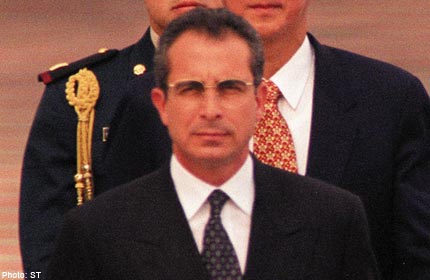By Alexandra Halsey-Storch
Impunity Watch Desk Reporter, Europe
MADRID, Spain — The United Nations World Tourism Organization held its annual Congress on Ethics and Tourism last week in Madrid, Spain with the stated purpose to encourage countries to “intensify efforts to place ethics at the core of tourism development.” While the tourism industry brings opportunities for jobs, economic growth and social power, it also brings “challenges that can’t be ignored.” Perhaps the biggest challenge the industry faces, in countries around the world, is the challenge to determine the means by which officials may eradicate the very pervasive, yet clandestine and often ignored, phenomenon of child sex tourism.

Child sex tourism is an industry that accommodates individuals who travel specifically for the purpose of engaging in sexual activities with children; however, within this context, the people who exploit children for sex are not necessarily pedophiles. More often, they can be described as “situational child sex tourists – “someone who abuses children by way of experimentation or through the anonymity and impunity afforded by being a tourist.” He or she does not have an exclusive sexual inclination for children.” This phenomenon span the globe, and can be found in increasing numbers in Eastern Europe, Latin America, South Africa and East Asia.
The statistics to date indicate that three to five million people travel each year with the sole purpose of exploiting young children for sexual advantages, and while the numbers range, it is estimated that 1.2 – 3 million children are trafficked each year throughout the world for the purpose of child sex tourism. Of these children, 80-90% are girls. Some suggest that these numbers are severely underreported and are actually far greater.
In 1997, the non-profit organization End Child Prostitution, Child Pornography, and Trafficking of Children for Sexual Purposes (ECPAT) spearheaded, developed and wrote the Code of Conduct for the Protection of Children From Sexual Exploitation in Travel & Tourism in an effort to thwart child sex tourism. The Code lays out six main principles for companies and associations of the tourism, travel and transport industry to adopt and follow. Eighty members and seventy countries have adopted the Code since 1998.
Since its inception, ECPAT has worked tirelessly to encourage more tourism counterparts to sign and adhere to the Code. They explain that vulnerable children are procured and channeled through commercial sex rings. Customers—mainly men—perpetuate the market simply by continuing to use children for sexual gratification. This market is virtually uninhibited as a result of corruption, collusion, lax law enforcement personnel, and a set of laws that are inadequate and/or absent.
While most customers are men, ECPAT has said that society at large is responsible for allowing this abuse to continue: family members, the business sector, service providers, customers, community leaders and government officials, all contribute to the exploitation through indifference to and ignorance of the harmful consequences suffered by children. Additionally, the desperation of poverty combined with a cultural and historically entrenched conception of children as economic commodities further perpetuates this business.
Child sex tourism in Eastern Europe, in particular, is a violent, criminal network dating back to the collapse of the Soviet Union. The dangerous nature of the industry in Eastern Europe has made it particularly difficult for ECPAT workers to successfully intervene.
In 2005, Cathrin Schauer, a social worker and nurse who works at a nongovernmental organization on the German-Czech border providing health and social services to prostitutes, gathered evidence of 500 children fallen prey to the child sex tourism industry. In her book, Children Walk the Streets, she says that parents and relatives act as pimps. For a couple of euros or a piece of candy for an older sibling, a mother will prostitute her three-year-old. Fifteen-year-old “Antonin” (the names in the book have been changed as safety precautions) says, “When the Germans ask for younger children, I bring them my six-year-old brother.”
As recent as April 2011, ECPAT and 30 other children’s rights organizations submitted a letter to the United Nations arguing that Sweden continues to fail to take appropriate measures in combating child sex tourism.
On Thursday, ECPAT, in collaboration with The Body Shop, submitted a petition with 7 million signatures to the United Nations—perhaps the largest petition the UN has ever received. The petition urges the UN to take action to stop the sex trafficking of children. “Offenders have been [and continue] operating with impunity,” said Kathleen Speake, executive director of ECPAT International, “and child victims are often criminalized or abandoned without care options;” however, the petition has already generated “unprecedented change,” by motivating the world to call for change and prompting 14 countries to adopt new legislation pertaining to child sex trafficking.
For more information, please visit:
The Irish Times — Don’t Let Child Abuse Travel – 24 September 2011
SOS Children’s Villages Canada – Tourism Industry Endorses Code of Conduct – 20 September 2011
World Tourism Organiztion UNWTO – Congress on Ethics and Tourism Opens With Calls to Place Ethics at the Core of Tourism Development – 15 September 2011
ECPAT International — Europe and CIS – September 2011
ECPAT International – Largest Ever Human Rights Petition to European Commission Calls for Action to Stop Sex Trafficking of Children – 28 June 2011
Child Protection in Europe – Childs Rights Group Slams Sweden on Sex Crimes – 13 April 2011
ECPAT International – ECPAT International: Report of the World Congress III Against Sexual Exploitation of Children and Adolescents – September 2009


